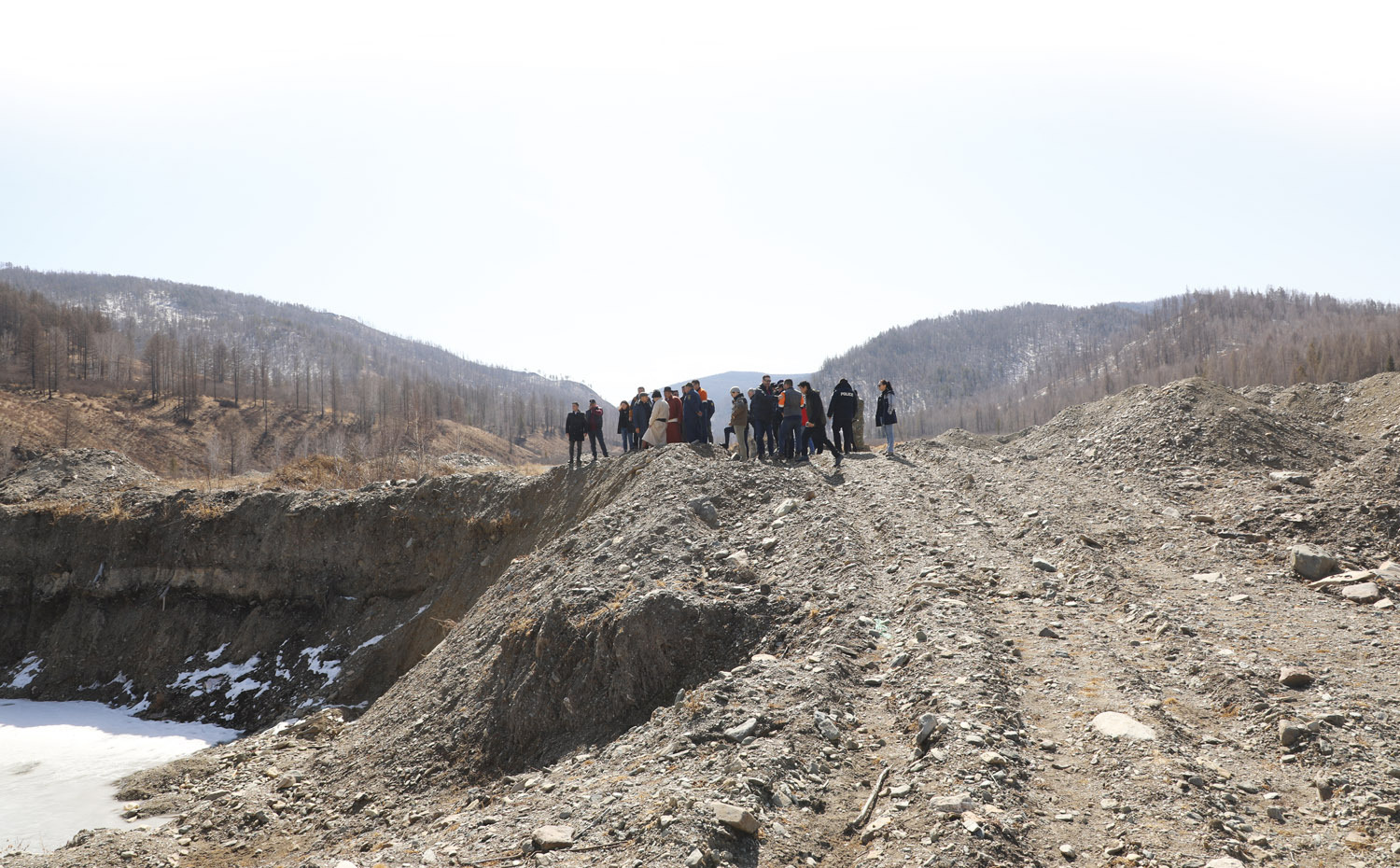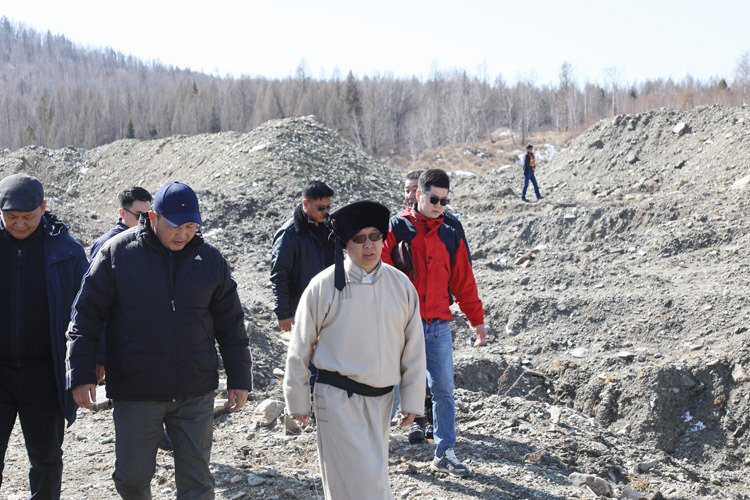
MMJ journalist B. Ariunaa spoke with the Minister of Environment and Tourism, B. Bat-Erdene about environmental legislation, subsoil, its use and protection, underground and surface water resources, and how to prevent soil erosion.
The revised draft Law on Environmental Protection will be discussed at the spring session of Parliament. A working group has been established to prepare any amendments. Could you tell us more about it?
Good governance is the best environmental protection. So, first, errors and distortions in the legal framework will be corrected and specific changes made to the process for monitoring implementation.
Supporting responsible mining is not only the task of the mining sector and heavy industry. It is directly linked to environmental, labor, social security, health and ecological issues. We are, therefore, working to ensure effective coordination and linkages between the legal frameworks of each sector. Instead of a legal system focused on a single sector, we will create a broader system that encompasses all interrelated sectors.
Since the launch of the New Revival Policy, the industry has experienced significant changes at the policy level. A new joint working group with representatives from the mining industry has been set up to review and amend the set of environmental laws.
The Ministry of Environment and Tourism, on the other hand, carries out proper environmental protection and environmental management, adheres to the principle of accountability, conducts evaluation and draws conclusions.
One example is the Law on Environmental Impact Assessment. Under this , we develop a general plan, conduct a detailed assessment, and approve a five-year management plan. However, in addition, we submit a management plan every year for approval. This leads to duplication of public services and increased bureaucracy. If a management plan is approved for five years, there is no need to approve it annually. The industry has sufficient numbers of inspectors to conduct monitoring and inspections.
In addition to the environmental challenges associated with mining, we face another pressing problem - pasture degradation and desertification, right?
We have already presented our policy at the Mining Week 2023 event. We believe that surface water is being used uncontrollably by the mining industry. However, according to numerous reports prepared by experts, agricultural and farming sectors also use a huge amount of water.
They conclude that mining destroys the environment by removing soil and altering the flow of rivers. However, local people also contribute to soil erosion. For example, they have created many additional dirt tracks by driving their cars around, causing more damage.. The Ministry of Environment and Tourism is undertaking many activities at the policy level to address this issue.
Mongolia is scheduled to host the Conference of the Parties to the International Convention to Combat Desertification in 2026 on soil degradation, for which preliminary work has already begun. Desertification affects 76.9% of the country’s total land area. Desertification is categorized as very severe, severe, moderate and green zone.
The Ministry of Environment and Tourism is conducting environmental training for herders on topics such as preventing soil degradation and overgrazing, water scarcity and the impact of climate change as part of the eco-friendly herder program for local communities. Mongolians are changing and have evolved a lot in terms of personal consciousness and personal development. We observe that local people’s attitudes towards mining are changing. Instead of just opposing mining, locals started asking questions such as whether nature will be restored and remain pristine; what benefits and jobs will mining companies create, and how will it affect the local population? Due to climate change and global warming, the number of livestock is decreasing every year, and how will local communities live in the future? Or maybe this mine will be closed in 10 years but the next generations will live in this area for 100 years and so on. Mongolians have learnt to discuss mining issues publicly. Therefore, we must develop and implement an effective mining policy suitable for local communities.


During your presentation at the Mining Week 2023 conference, you mentioned the storage and utilization of surface water resources in the Gobi region. If projects and programs are implemented effectively, can they solve water problems in the Gobi region?
The Blue Horse project has been discussed for a long time. But it stopped because of some politicians. They misused the citizens’ intentions to protect their land. There are problems related to international agreements on water.
As part of the Man and the Biosphere program implemented by UNESCO, we have conducted a number of studies and prepared reports jointly with Russia and China.
From this we can see that our priority is to conclude an agreement on transboundary waters. Why can’t we fully utilize solar, wind and water energy, despite the fact that we live in the highlands of Central Asia? The energy of the sun and wind belongs to all , while water is connected to the veins of the earth. It is a treasure.
Therefore, when we talk about water, we necessarily touch upon the issue of water along the border. We have also joined international conventions. In the future, our Gobi region will only be able to have water if projects such as the Blue Horse, Orkhon Gobi and Kherlen Gobi are realized.
To date, there are five aimags where permafrost is not discovered: the four Gobi aimags plus Sukhbaatar aimag. So we must raise the issue of how not to lose our permafrost.
We started work on the feasibility study of the Kherlen Gobi project together with Rio Tinto and Oyu Tolgoi. A project that was talked about in 2014 is finally breaking the deadlock. Funding for the project will be around $3 million. The Orkhon Gobi project was first initiated in 2020, and based on a feasibility study, design work has begun.
It is planned to increase the protected area to 30% by 2030. How are you going to manage protected areas in coordination with mining areas?
We are not only living in the present time. Land is passed on to the next generation. In the future, protected areas may generate more income than mining. High-rise buildings and technology are no longer of interest. Wildlife is a subject of interest today. That is why it is planned to amend the law on special protected areas and increase the area of protected land to 30% in 2030. Currently, 21% of the total area, or 33.8 million hectares, is under special state protection. This is equal to the territory of modern-day Poland.
We are not against mining. We need to address the question of how to develop responsible mining. On the other hand, there is the question of how to limit irresponsible activities.
A report from the Ministry of Environment and Tourism said restoration work on damaged and abandoned areas is well underway. Can you explain what alternative environmental protection measures there are?
The government’s Action Program for 2020-2024 includes the rehabilitation of 8,000 hectares of abandoned and derelict land.
To date, the Ministry of Environment and Tourism has already restored 12,353 hectares of land. In other words, the area of restored land has been exceeded by 4,350 ha. There remain 8,000 hectares of abandoned land and 22,000 hectares of land with an established owner. This is a total of 30,000 hectares. 22,000 hectares of land have owners.
The people who operated in the area between 1997 and 2012 have been identified and their cases are now being handled by authorities. These people must be held accountable. They had a clever way of taking the land, using it, and then leaving it to illegal goldminers when the work was finished. These people seek to avoid the responsibility of rehabilitating their lands. We are firmly committed to the position that once you have taken the land and used it, you have to restore it.
What is your policy on reducing the environmental impact of mining companies?
The legal framework needs to be clearer. In the past, legal liability for environmental damage and river pollution was very weak and not enforced at all.. Now we must find out where we made mistakes and why we got such poor results.
The United Nations has unanimously declared that “global warming and climate change are affecting humanity”. There is therefore an urgent need to move towards a system in which everyone supports each other and works in mutual coordination within an effective legal framework.
Parties express different positions on the reform of the legal system related to mining. Today, there is a legal system in place where all issues related to the use of mining are publicly discussed. However, there are quite a lot of companies that issued IPOs on the international stock exchange and are interested in working on exploration and mining projects that will benefit the local region. Unfortunately, these projects are stalled due to local opposition.
It is therefore important to distinguish between responsible and irresponsible, standard and non-standard mining. Compared to 1990, the public’s understanding of mining has increased today.
Mining operations are now more organized. Modern advanced technologies are widely used in the mining industry. The legislative framework is also changing. We will therefore focus on creating an efficient system that ensures that the population benefits from mining and that international standards are met.